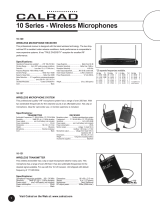Page is loading ...

PowerFilm, Inc. • 1287 XE Place • Ames, IA 50014 USA • www.powerlmsolar.com • 515-292-7606 9/21
Electronic Component Solar Panel Handling
General Information
Testing: All panels are tested for rated power output under rated light intensity before leaving our facility.
Lifetime: Under rated conditions, amorphous silicon PV has excellent longevity. Weatherproofed panels are IP68 rated and constructed with
20-year rated UV resistant materials. Lifetimes of 10+ years for outdoor installations and 20+ years for indoor installations are expected.
Connection: Tinned foil tape on either side of the module creates functional positive and negative connection points. Burn/scrape through
the protective laminate at any point on the foil tape to solder or make a connection. Pre-exposed front or back contact options are available.
Encapsulation: Standard or high-performance laminates are applied via roll process to provide excellent top and bottom side protection.
Modules without an edge seal are not protected from long-term exposure to condensing moisture or water.
Staebler-Wronski Eect: Power output will fall approximately 10% over the rst 100h of sun exposure due to light-induced material
changes. During this time, the material structure will stabilize, and panels will have excellent long-term power stability.
Handling and Assembly
DO NOT crease, kink, fold, cut, pinch or stretch panels within the active PV area (any area between the positive and negative foil tape).
This will cause permanent damage of varying severity.
NOT COMPATIBLE with SMT solder reow in an oven, which signicantly exceeds rated panel laminate temperature.
Static Discharge: Static discharge across leads or unsealed module edges can cause damage and decrease performance. Indoor modules are
more susceptible than standard modules. ESD mitigation, including humidied work areas, anti-static mats/surfaces, anti-static clothing, and
anti-static blowers, are recommended during handling and assembly.
Gloves: Wear gloves while handling to keep surfaces clean of oil, residue, and ngerprints.
Cleaning: Isopropanol can be used to remove oil, residue, or ngerprints from the panel surface. Wipe dry. Consult PowerFilm if more
involved cleaning is necessary.
Soldering: Leads or contacts can be soldered to any location along the frontside of the positive and negative foil bus tape. Solder on a heat-
dissipating surface at low iron temperature to reduce local laminate distortion. Burn through the protective laminate and place solder dots
before soldering tinned leads. Soldering in the middle of the tape away from an edge is recommended for best results.
Backside Contacts: Backside (or frontside) contacts can be exposed in pre-dened locations with foil bus tape. Contact PowerFilm for
custom requirements.
Conductive Epoxy: Conductive epoxy with low curing temperature can be used to make contact with exposed contacts. Source epoxy that
meets the mechanical, electrical, and manufacturing requirements for your application. Contact or visit powerlmsolar.com for more details.
FPC Connector Tabs: Panels can be manufactured with exposed tabs that insert into board-mounted FPC connectors. Contact or visit
powerlmsolar.com for more details.
Plated Through Slots: Panels can be manufactured with exposed solder tabs that can be inserted through a plated slot in a PCB and
reowed with selective solder techniques. Contact or visit powerlmsolar.com for more details.
/




